Graz Lagrangian Model (GRAL) for Pollutants Tracking and Estimating Sources Partial Contributions to Atmospheric Pollution in Highly Urbanized Areas
Abstract
1. Introduction
2. Experiments
2.1. Krasnoyarsk Greater Area Specifics
- A heterogeneous landscape (eight high-rise terraces; elevation from 117 to 708 m.a.s.l.); the city is located in a hollow, surrounded by the hills—spurs of the Sayan mountains (Figure 2);
- Continental climate contrasts with the ice-free Yenisei River—the effect of evaporation seriously impacts on the air flows and complicates modeling due to the significant temperature difference of water and the environment (even at −40 degrees Celsius, the river bed is not covered with ice within the boundaries of the agglomeration because of the hydroelectric dam 30 km upstream; the area of non-freezing surface is 29 km2);
- Emissions dispersion deterioration in the surface layer as high-rise buildings exaggerate the landform;
- The private sector households heated individually without a centralized system (by lignite or firewood).
- Gross emissions are increasing by heating and energy supply because of the civil construction growth.
- The increasing number of vehicles contributes to the rise in gross emissions, as well as the loads on roads net gives additional emissions from traffic jams. Industrial production growth also (metallurgy, chemical, pharmaceutical, development, woodworking, radio engineering production, etc.)
2.2. Model Description and Data Preparation
2.3. Improvement of the GRAMM/GRAL Model to Better Match the Regional Specifics
- Methodology upgrade.
- The vertical temperature gradient adjusting.
- The river evaporation effect considering.
- Data preparation for the model verification.
2.4. Input Datasets and their Parameters
2.4.1. D Landform (Landscape) Model
2.4.2. Land-Use Data and Landcover Vegetation Data
2.4.3. Buildings
2.4.4. Meteorological Parameters
2.4.5. Air Pollutants
2.4.6. Sources of Pollutants
2.4.7. Motor Road Network Source
2.4.8. Private Households Emissions
2.4.9. Emission Sources Time Profiles
2.4.10. Air Quality Observation Stations
3. Results
- Speed and azimuth direction of wind;
- Partial contribution to the concentration of five pollutants from each of the main groups of sources listed above (Table 4).
3.1. Comparative Analysis of Wind Flow Trends—Simulated vs. Measured
3.2. Schematic Maps Characterizing the Emissions Dispersion for the Beginning and the End of AWC
3.3. Diagrams of Partial Contributions of the Main Groups Emission Source
3.4. Comparative Tables for Each Pollutant Measured and Simulated Values
4. Discussion
- Satisfactory modeling criteria are achieved when the difference between simulated and observed concentrations values is below one fraction of the maximum permissible concentration pollutant.
- Outstanding model-to-observe fitness quality—when the amount of difference between the modeled and observed concentrations are below a one-tenth share of the maximum permitted concentration.
- The initial meteorological conditions parameters were based on the data of only one observation point;
- Modeling spatial resolution was limited to 30 m;
- Emission sources descriptions and their modes of operation were based on the available official data (relevant for 2012–2017), part of the data was restored independently according to the period of 2019–2020; and emissions from unaccounted sources (unregistered small businesses) were not considered in the model (they can contribute significantly to pollution);
- Possible metrological problems at measuring points could affect the model verification.
5. Conclusions
- Clarification of data on sources (especially for BaP), formation of a completer and a more up-to-date database;
- Use data from several weather stations throughout the modeling domain for a more accurate setting up of meteorological parameters;
- Modeling with a finer spatial mesh;
- Comparing the GRAL/GRAMM with Gaussian (and others) methods through a retro experiment;
- Development of methods for the verification of computational models based on remote sensing data.
Supplementary Materials
Author Contributions
Funding
Acknowledgments
Conflicts of Interest
References
- Das, P.; Horton, R. Pollution, health, and the planet: Time for decisive action. Lancet 2018, 391, 407–408. [Google Scholar] [CrossRef]
- Tang, K.; Qiu, Y.; Zhou, D. Does command-and-control regulation promote green innovation performance? Evidence from China’s industrial enterprises. Sci. Total Environ. 2020, 712, 136362. [Google Scholar] [CrossRef] [PubMed]
- Fragkou, E.; Douros, I.; Moussiopoulos, N.; Belis, C.A. Current trends in the use of models for source apportionment of air pollutants in Europe. Int. J. Environ. Pollut. 2012, 50, 363. [Google Scholar] [CrossRef]
- Efthimiou, G.C.; Andronopoulos, S.; Tavares, R.; Bartzis, J. CFD-RANS prediction of the dispersion of a hazardous airborne material released during a real accident in an industrial environment. J. Loss Prev. Process. Ind. 2017, 46, 23–36. [Google Scholar] [CrossRef]
- Leelőssy, Á.; Molnár, F.; Izsák, F.; Havasi, Á.; Lagzi, I.; Mészáros, R. Dispersion modeling of air pollutants in the atmosphere: A review. Open Geosci. 2014, 6, 30. [Google Scholar] [CrossRef]
- Holmes, N.S.; Morawska, L. A review of dispersion modelling and its application to the dispersion of particles: An overview of different dispersion models available. Atmos. Environ. 2006, 40, 5902–5928. [Google Scholar] [CrossRef]
- Tominaga, Y.; Stathopoulos, T. CFD simulation of near-field pollutant dispersion in the urban environment: A review of current modeling techniques. Atmos. Environ. 2013, 79, 716–730. [Google Scholar] [CrossRef]
- Sheih, C. A puff pollutant dispersion model with wind shear and dynamic plume rise. Atmos. Environ. 1978, 12, 1933–1938. [Google Scholar] [CrossRef]
- Sun, S.; Li, H.; Fang, S. A forward-backward coupled source term estimation for nuclear power plant accident: A case study of loss of coolant accident scenario. Ann. Nucl. Energy 2017, 104, 64–74. [Google Scholar] [CrossRef]
- Koracin, D.; Vellore, R.; Lowenthal, D.H.; Watson, J.G.; Koracin, J.; Mccord, T.; Dubois, D.W.; Chen, L.-W.A.; Kumar, N.; Knipping, E.M.; et al. Regional Source Identification Using Lagrangian Stochastic Particle Dispersion and HYSPLIT Backward-Trajectory Models. J. Air Waste Manag. Assoc. 2011, 61, 660–672. [Google Scholar] [CrossRef]
- Ministry of Natural Resources Order #273 of 6 June 2017. Available online: https://minjust.consultant.ru/files/36322 (accessed on 4 November 2020).
- Cai, X.-M. Effects of differential wall heating in street canyons on dispersion and ventilation characteristics of a passive scalar. Atmos. Environ. 2012, 51, 268–277. [Google Scholar] [CrossRef]
- Yuan, C.; Norford, L.; Ng, E. A semi-empirical model for the effect of trees on the urban wind environment. Landsc. Urban. Plan. 2017, 168, 84–93. [Google Scholar] [CrossRef]
- Aristodemou, E.; Boganegra, L.M.; Mottet, L.; Pavlidis, D.; Constantinou, A.; Pain, C.; Robins, A.; ApSimon, H. How tall buildings affect turbulent air flows and dispersion of pollution within a neighbourhood. Environ. Pollut. 2018, 233, 782–796. [Google Scholar] [CrossRef] [PubMed]
- Shen, Z.; Cui, G.; Zhang, Z. Turbulent dispersion of pollutants in urban-type canopies under stable stratification conditions. Atmos. Environ. 2017, 156, 1–14. [Google Scholar] [CrossRef]
- Aristodemou, E.; Mottet, L.; Constantinou, A.; Pain, C.C. Turbulent Flows and Pollution Dispersion around Tall Buildings Using Adaptive Large Eddy Simulation (LES). Buildings 2020, 10, 127. [Google Scholar] [CrossRef]
- Ministry of Ecology and Rational Nature Management of the Krasnoyarsk Region. Regional State Budgetary Institution Center for the Implementation of Measures for the Use of Natural Resources and Environmental Protection of the Krasnoyarsk Region. Operational Environmental Situation. Available online: http://krasecology.ru/Operative/Air (accessed on 4 November 2020).
- Shaparev, N.; Tokarev, A.; Yakubailik, O.E. The state of the atmosphere in the city of Krasnoyarsk (Russia) in indicators of sustainable development. Int. J. Sustain. Dev. World Ecol. 2019, 27, 349–357. [Google Scholar] [CrossRef]
- IQAir. World’s most Polluted Cities 2019 (PM2.5). Available online: https://www.iqair.com/world-most-polluted-cities?continent=59af92ac3e70001c1bd78e52&country=qNvxAidZLbwhRmQXR&state=&page=1&perPage=50&cities= (accessed on 4 November 2020).
- Bloomberg. Siberian Black Skies Have Russia’s Dirtiest City Begging for Gas. Available online: https://www.bloomberg.com/news/articles/2020-06-12/siberian-black-skies-have-russia-s-dirtiest-city-begging-for-gas (accessed on 4 November 2020).
- Russian Emission Limits 2017. Available online: http://www.krasecology.ru/Data/PDV/%D0%9A%D1%80%D0%B0%D1%81%D0%BD%D0%BE%D1%8F%D1%80%D1%81%D0%BA.zip (accessed on 4 November 2020).
- Lin, C.; Labzovskii, L.; Mak, H.W.L.; Fung, J.C.; Lau, A.K.; Kenea, S.T.; Bilal, M.; Hey, J.D.V.; Lu, X.; Ma, J. Observation of PM2.5 using a combination of satellite remote sensing and low-cost sensor network in Siberian urban areas with limited reference monitoring. Atmos. Environ. 2020, 227, 117410. [Google Scholar] [CrossRef]
- Litovchenko, V.I.; Misuna, I.I.; Shumakova, N.A. Contemporary analysis of Krasnoyarsk environmental problems. IOP Conf. Ser. Mater. Sci. Eng. 2020, 822, 12013. [Google Scholar] [CrossRef]
- Zavoruev, V.V.; Zavorueva, E.N. Instrumental determination of the location of benzo[a]pyrene emission sources. IOP Conf. Ser. Mater. Sci. Eng. 2019, 537, 62070. [Google Scholar] [CrossRef]
- Meshkova, V.D.; A Dekterev, A.; A Gavrilov, A.; A Filimonov, S.; Litvintsev, K.Y. Modeling the influence of the river on the wind pattern of Krasnoyarsk. J. Phys. Conf. Ser. 2020, 1565, 12023. [Google Scholar] [CrossRef]
- Berchet, A.; Zink, K.; Oettl, D.; Brunner, J.; Emmenegger, L.; Brunner, D. Evaluation of high-resolution GRAMM–GRAL (v15.12/v14.8) NOx simulations over the city of Zürich, Switzerland. Geosci. Model. Dev. 2017, 10, 3441–3459. [Google Scholar] [CrossRef]
- Oettl, D.; Veratti, G. A comparative study of mesoscale flow-field modelling in an Eastern Alpine region using WRF and GRAMM-SCI. Atmos. Res. 2021, 249, 105288. [Google Scholar] [CrossRef]
- Ling, H.; Lung, S.-C.C.; Uhrner, U. Micro-scale particle simulation and traffic-related particle exposure assessment in an Asian residential community. Environ. Pollut. 2020, 266, 115046. [Google Scholar] [CrossRef] [PubMed]
- Graz Lagrangian Model. Available online: https://gral.tugraz.at/ (accessed on 4 November 2020).
- Krasnoyarsk Winter Universiade 2019. Available online: https://krsk2019.ru/en (accessed on 4 November 2020).
- Jones, J.E.; Cohen, J. A Diagnostic Comparison of Alaskan and Siberian Strong Anticyclones. J. Clim. 2011, 24, 2599–2611. [Google Scholar] [CrossRef]
- List of Weather Station Indices (Synoptic Index). Available online: http://meteomaps.ru/meteostation_codes.html (accessed on 4 November 2020).
- Hydrometeorological Data RIHMI—WDC. Available online: http://meteo.ru/english/data/ (accessed on 4 November 2020).
- GitHub, Inc. Gral Dispersion Model Repository. Available online: https://github.com/GralDispersionModel (accessed on 4 November 2020).
- Oettl, D. Evaluation of the Revised Lagrangian Particle Model GRAL Against Wind-Tunnel and Field Observations in the Presence of Obstacles. Bound. Layer Meteorol. 2015, 155, 271–287. [Google Scholar] [CrossRef]
- Salim, S.M.; Buccolieri, R.; Chan, A.; Di Sabatino, S. Numerical simulation of atmospheric pollutant dispersion in an urban street canyon: Comparison between RANS and LES. J. Wind. Eng. Ind. Aerodyn. 2011, 99, 103–113. [Google Scholar] [CrossRef]
- GRAL—Graz Lagrangian Model. Documentation and User Guides. Available online: https://gral.tugraz.at/index.php/files/category/3-documentation-and-user-guides (accessed on 28 November 2020).
- Ministry of Ecology Analytical Report for 5–8 December 2018. Available online: http://krasecology.ru/Storage/Index?guid=78cc3998-1f0c-46dc-ad01-344326faf666 (accessed on 4 November 2020).
- PostgreSQL. Available online: https://www.postgresql.org/ (accessed on 4 November 2020).
- CORINE Land Cover. Available online: https://land.copernicus.eu/pan-european/corine-land-cover (accessed on 4 November 2020).
- Shuttle Radar Topography Mission. Available online: https://www2.jpl.nasa.gov/srtm/ (accessed on 4 November 2020).
- OGC GeoTIFF. Available online: https://www.ogc.org/standards/geotiff (accessed on 4 November 2020).
- QGIS Open Source Geographic Information System. Available online: https://qgis.org/en/site/ (accessed on 4 November 2020).
- ESRI ASCII Raster Format. Available online: http://resources.esri.com/help/9.3/arcgisengine/java/GP_ToolRef/spatial_analyst_tools/esri_ascii_raster_format.htm (accessed on 4 November 2020).
- Geofabrik Downloads. OpenStreetMap. Available online: https://download.geofabrik.de/russia/siberian-fed-district.html (accessed on 4 November 2020).
- Landsat Science. Landsat-8. Available online: https://landsat.gsfc.nasa.gov/landsat-8/ (accessed on 4 November 2020).
- Sentinel Online. Sentinel-2. Available online: https://sentinel.esa.int/web/sentinel/missions/sentinel-2 (accessed on 4 November 2020).
- Space Research Institute. Forest Cover Maps. Available online: http://smiswww.iki.rssi.ru/default.aspx?page=356 (accessed on 4 November 2020).
- Environmental Systems Research Institute. ESRI Shapefile Technical Description. Available online: https://www.esri.com/library/whitepapers/pdfs/shapefile.pdf (accessed on 4 November 2020).
- 2GIS. Krasnoyarsk. Available online: https://2gis.ru/krasnoyarsk (accessed on 4 November 2020).
- Weather Station 29570 Data. Available online: http://meteo.krasnoyarsk.ru/map_p/fr2.htm?mode=10 (accessed on 4 November 2020).
- Weather Station 29572 Data. Available online: http://meteo.krasnoyarsk.ru/map_p/fr2.htm?mode=17 (accessed on 4 November 2020).
- WHO. Ambient Air Pollution: Pollutants. Available online: https://www.who.int/airpollution/ambient/pollutants/en/ (accessed on 10 October 2020).
- Bernstein, J.A.; Alexis, N.; Barnes, C.; Bernstein, I.L.; Nel, A.; Peden, D.; Diaz-Sanchez, D.; Tarlo, S.M.; Williams, P.B. Health effects of air pollution. J. Allergy Clin. Immunol. 2004, 114, 1116–1123. [Google Scholar] [CrossRef]
- Manisalidis, I.; Stavropoulou, E.; Stavropoulos, A.; Bezirtzoglou, E. Environmental and Health Impacts of Air Pollution: A Review. Front. Public Health 2020, 8. [Google Scholar] [CrossRef]
- Abdel-Shafy, H.I.; Mansour, M.S. A review on polycyclic aromatic hydrocarbons: Source, environmental impact, effect on human health and remediation. Egypt. J. Pet. 2016, 25, 107–123. [Google Scholar] [CrossRef]
- Mannucci, P.M.; Franchini, M. Health Effects of Ambient Air Pollution in Developing Countries. Int. J. Environ. Res. Public Health 2017, 14, 1048. [Google Scholar] [CrossRef]
- Office of the Federal State Statistics Service for the Krasnoyarsk Region, the Khakassia Republic and the Tyva Republic. Transport. Available online: https://krasstat.gks.ru/folder/76652 (accessed on 4 November 2020).
- Yandex Map Service. Krasnoyarsk. Available online: https://yandex.ru/maps/62/krasnoyarsk/?ll=92.850000%2C56.010000&z=12 (accessed on 4 November 2020).
- Information Network Techexpert. Methodology for Determining Emissions of Pollutants Into the Atmosphere During Fuel Combustion in Boilers with a Capacity of Less than 30 Tons of Steam per Hour or Less than 20 GCal per Hour. Available online: http://docs.cntd.ru/document/1200031340 (accessed on 4 November 2020).
- Global Energy Monitor Wiki. Borodinsky coal mine. Available online: https://www.gem.wiki/Borodinsky_coal_mine (accessed on 4 November 2020).
- Plotly. Available online: https://plotly.com/ (accessed on 4 November 2020).
- Berchet, A.; Zink, K.; Muller, C.; Oettl, D.; Brunner, J.; Emmenegger, L.; Brunner, D. A cost-effective method for simulating city-wide air flow and pollutant dispersion at building resolving scale. Atmos. Environ. 2017, 158, 181–196. [Google Scholar] [CrossRef]
- Berchet, A.; Zink, K.; Emmenegger, L.; Brunner, J.; Muller, C.; Brunner, D. Modelling High-Resolution City-Wide Pollutant Concentrations in Zürich and Lausanne. In Proceedings of the GRAMM/GRAL Workshop, Graz, Austria, 6 July 2016; Available online: https://gral.tugraz.at/index.php/files/send/5-presentations/52-presentations-4th-gral-workshop-innsbruck (accessed on 4 November 2020).
- Thunis, P.; Pederzoli, A.; Pernigotti, D. Performance criteria to evaluate air quality modeling applications. Atmos. Environ. 2012, 59, 476–482. [Google Scholar] [CrossRef]
- European Environmental Agency. Forum for Air Quality Modelling in Europe (FAIRMODE). Available online: https://www.eea.europa.eu/themes/air/links/networks/forum-for-air-quality-modelling (accessed on 4 November 2020).
- Gao, J.; Tian, G.; Sorniotti, A.; Karci, A.E.; Di Palo, R. Review of thermal management of catalytic converters to decrease engine emissions during cold start and warm up. Appl. Therm. Eng. 2019, 147, 177–187. [Google Scholar] [CrossRef]
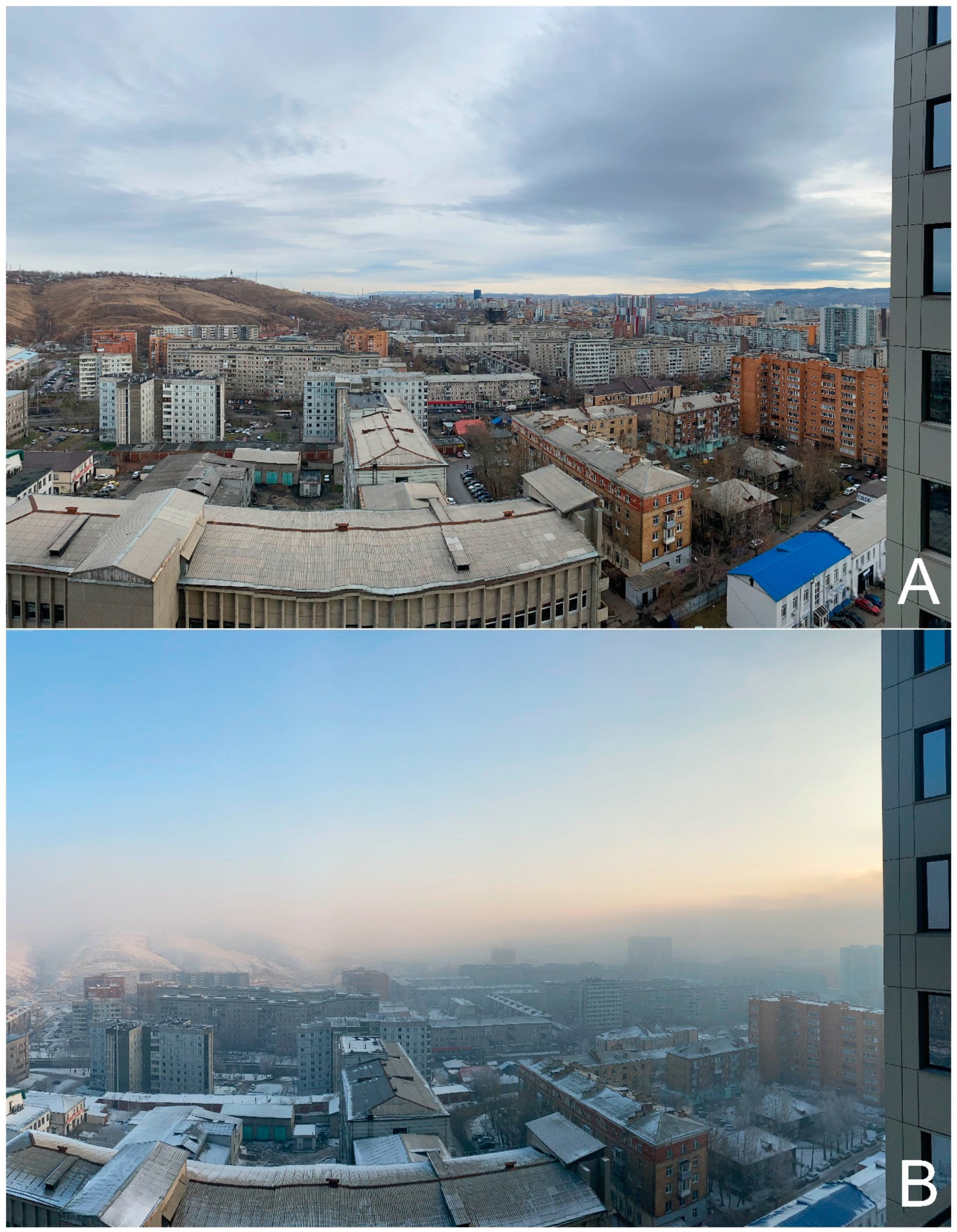
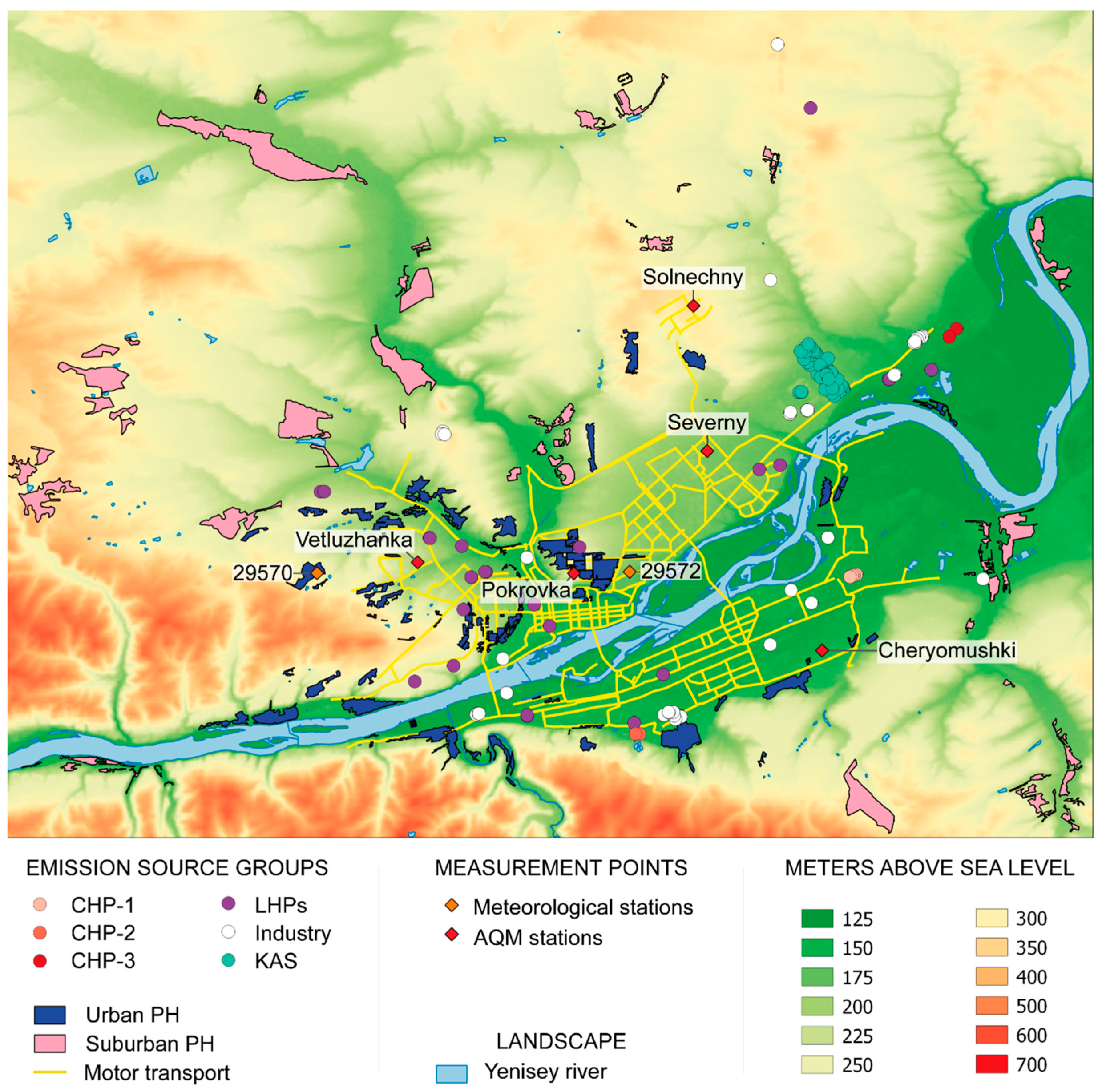


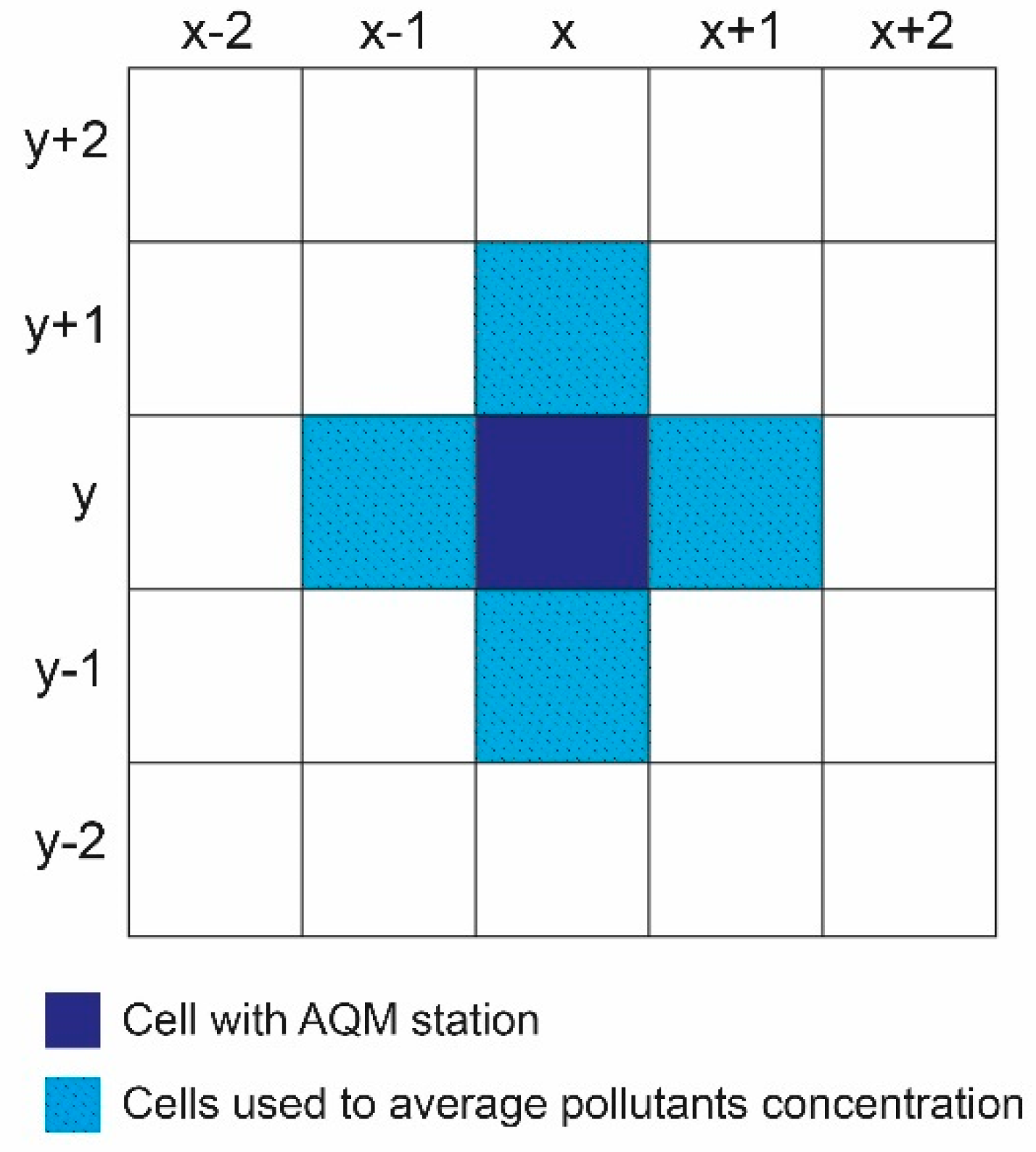
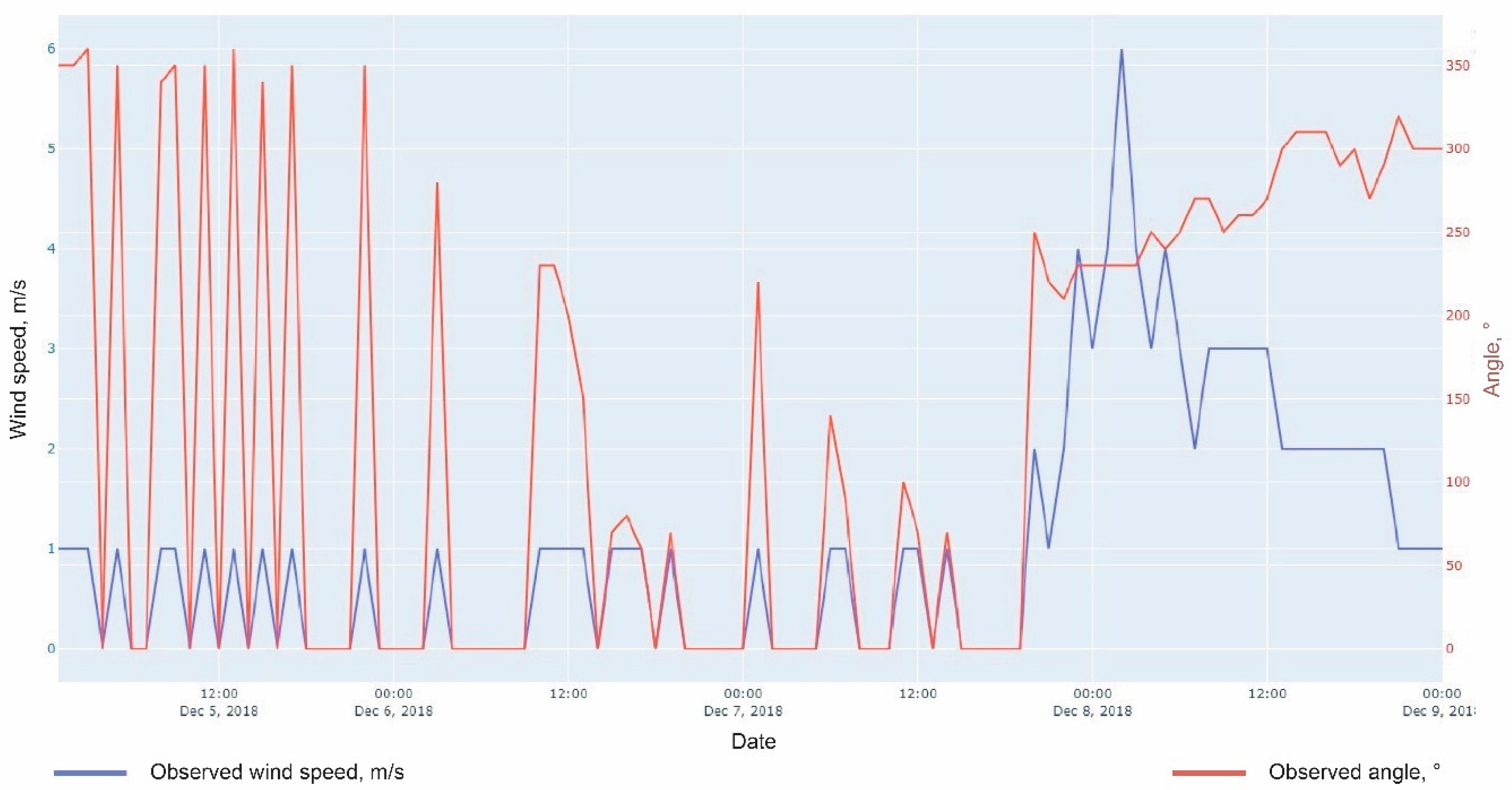
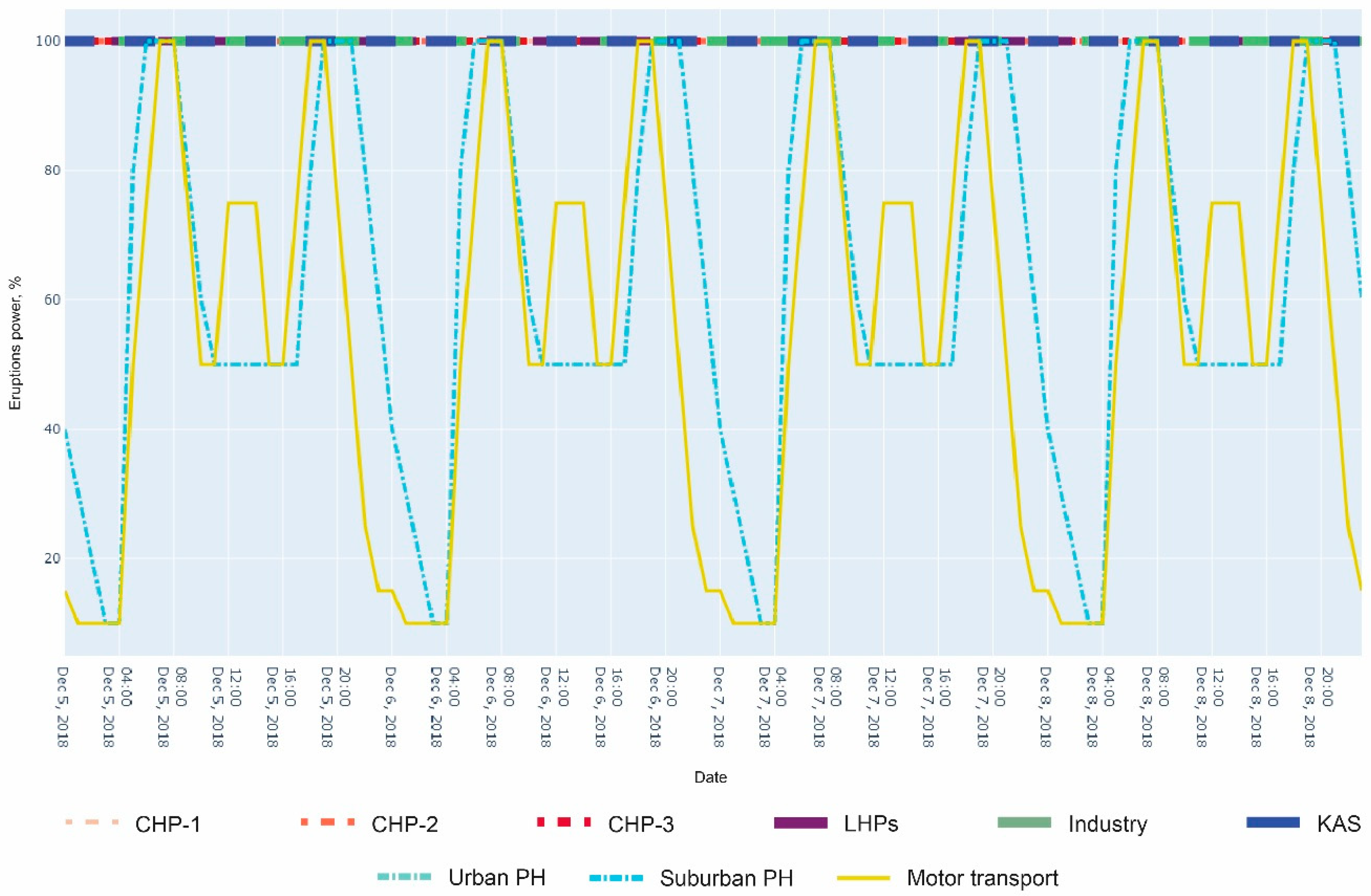
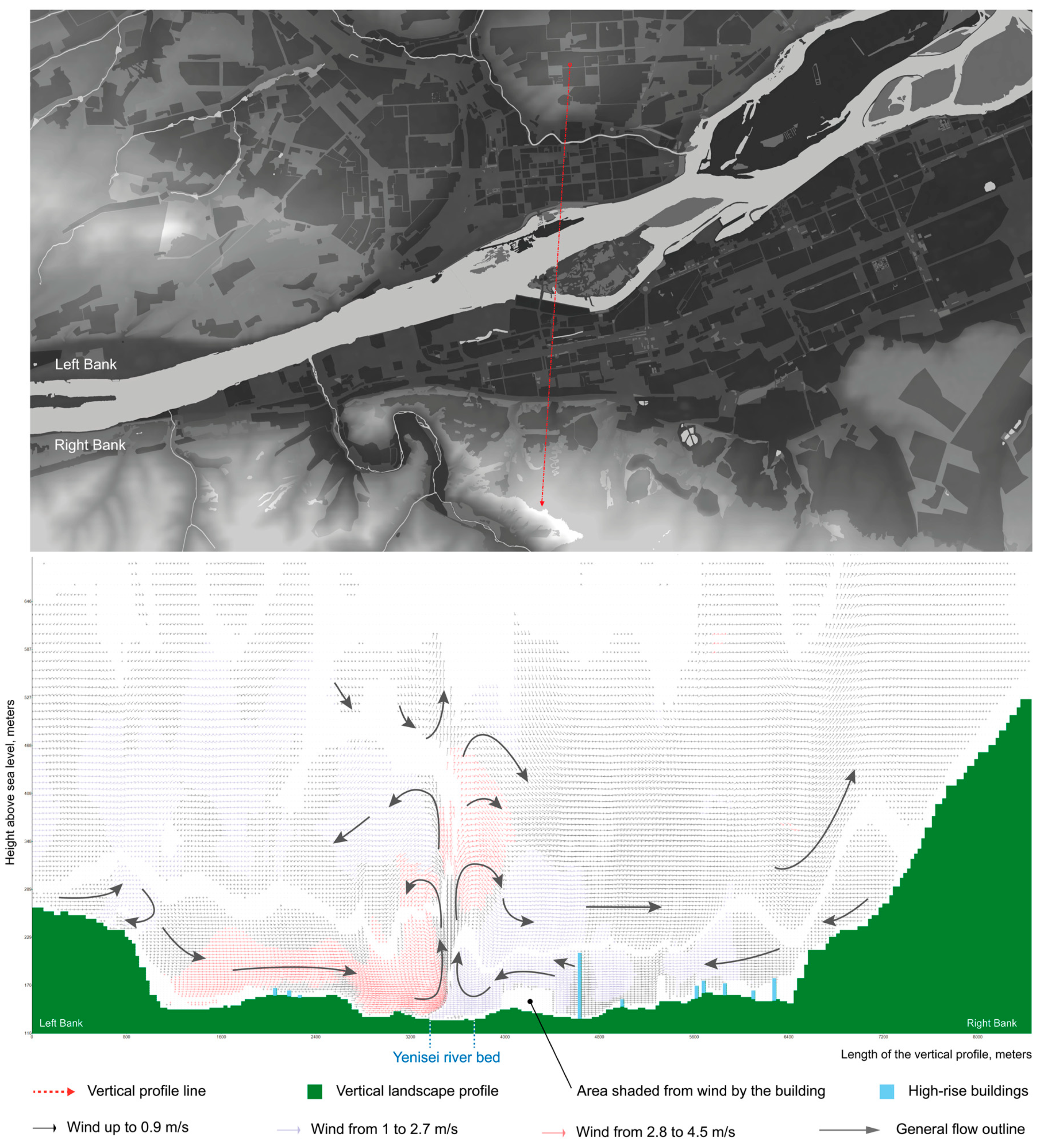
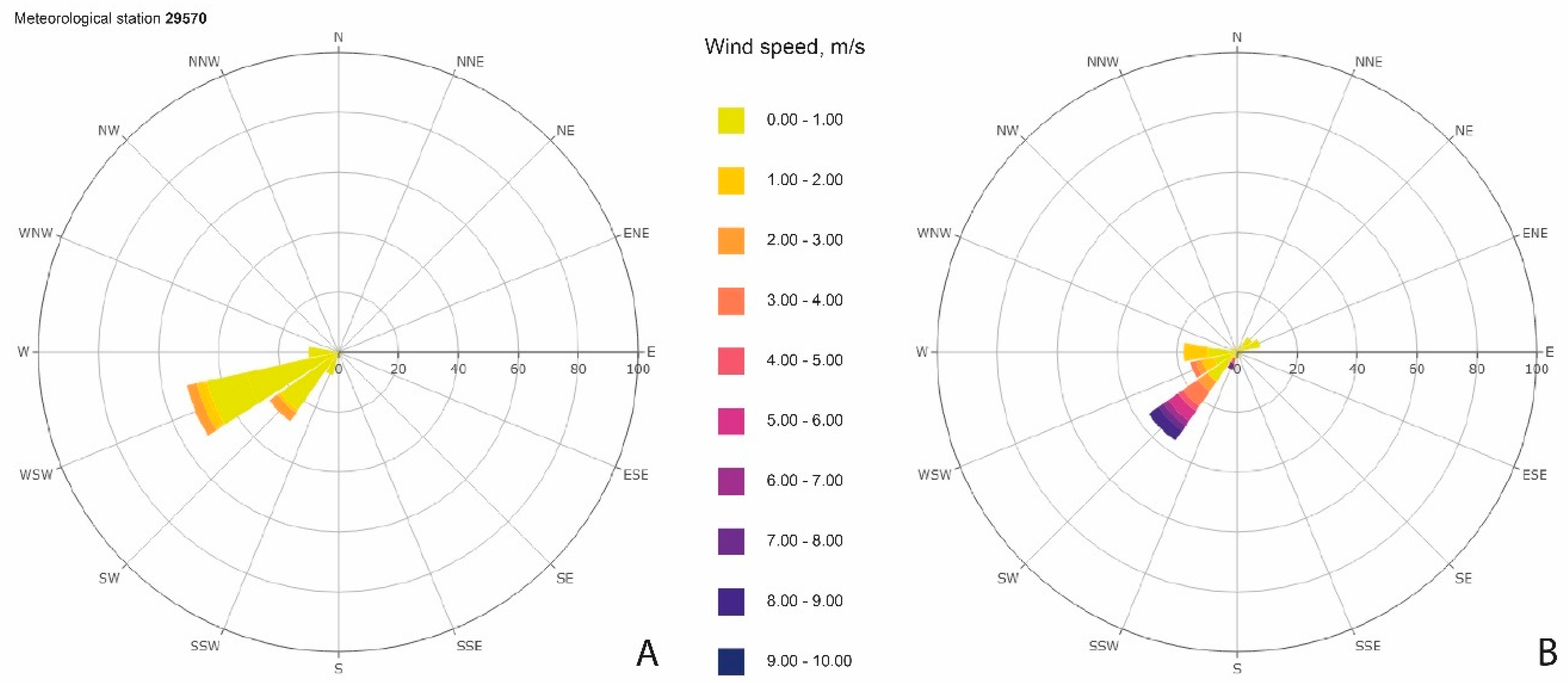
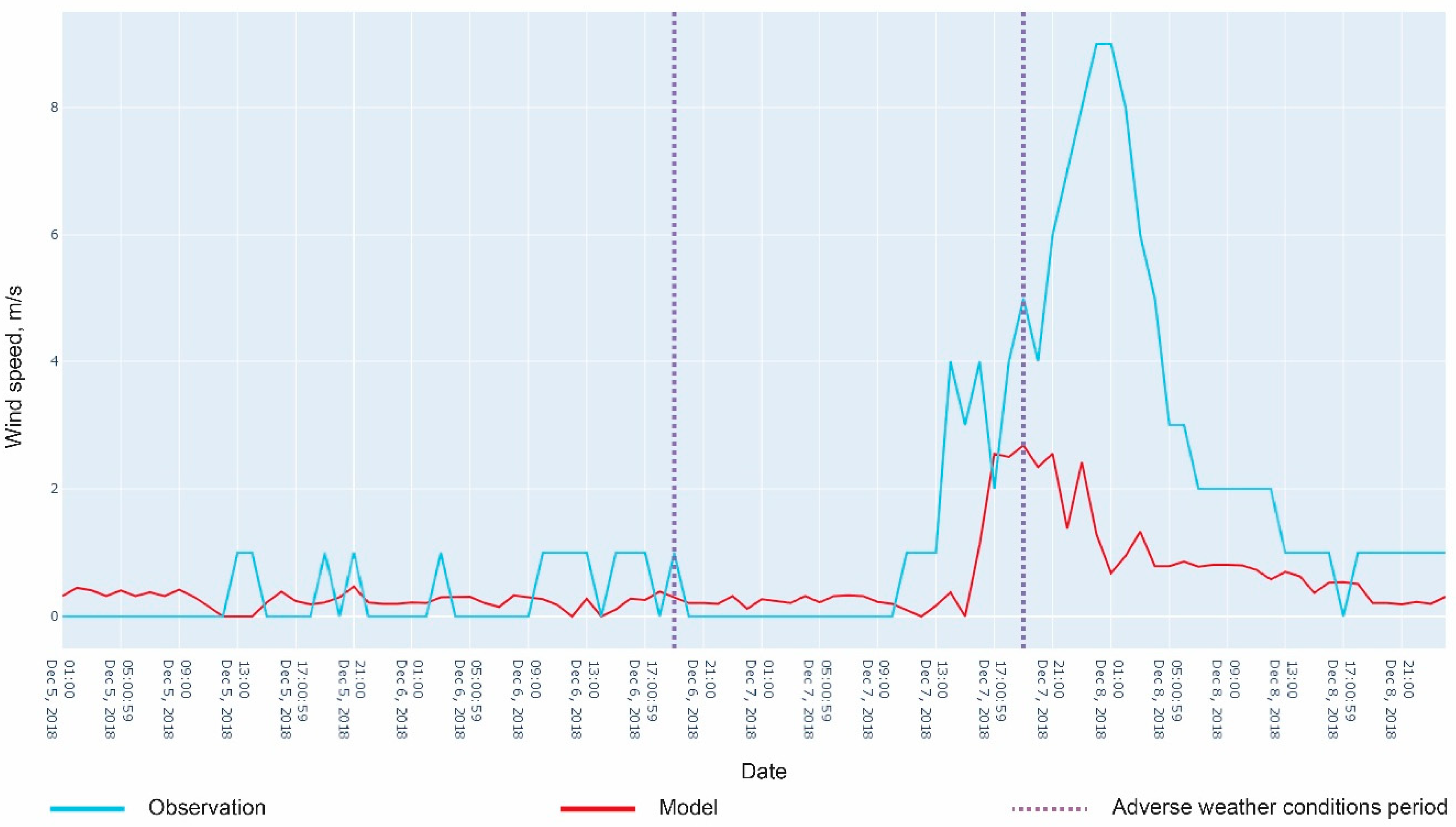
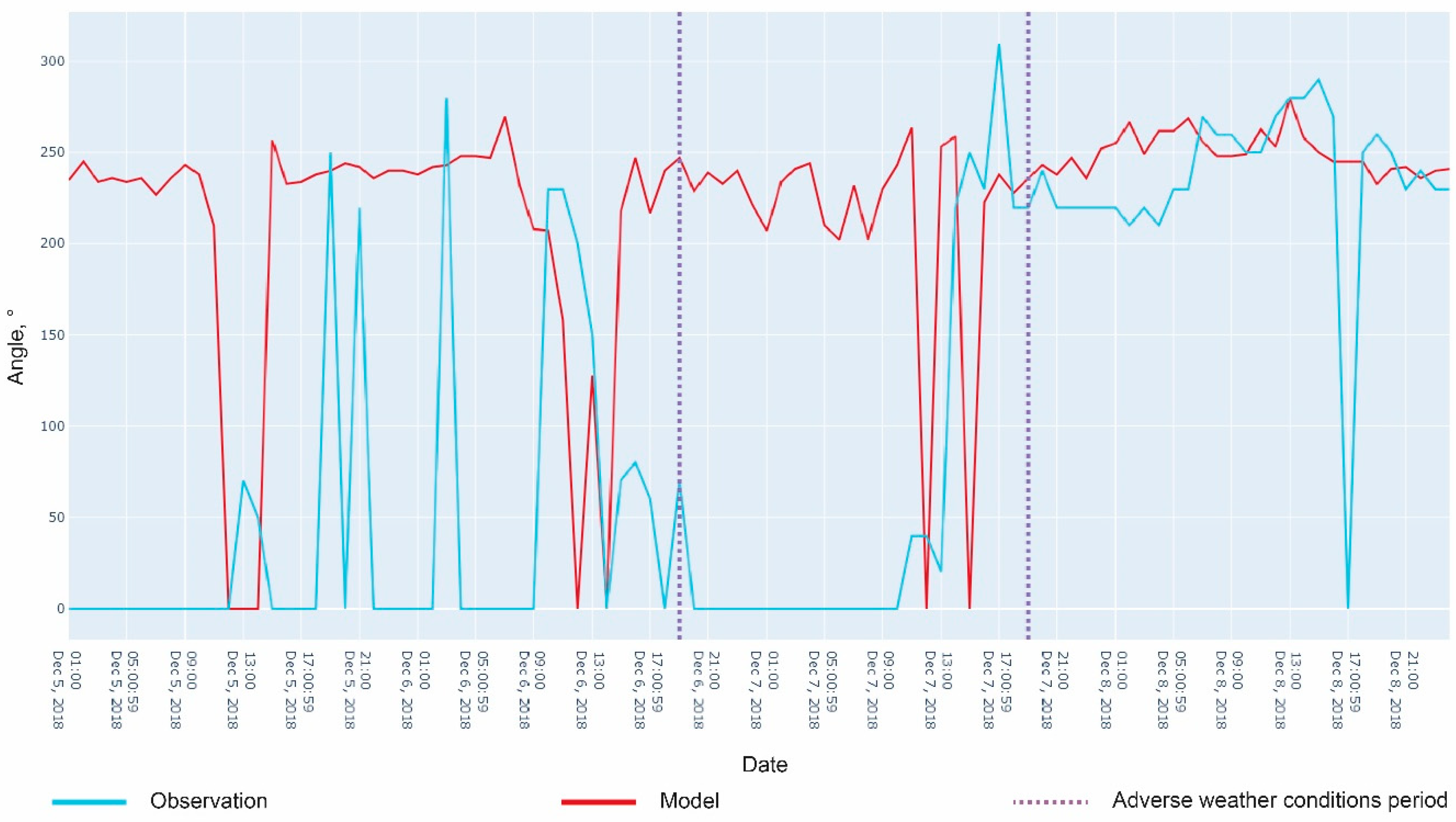
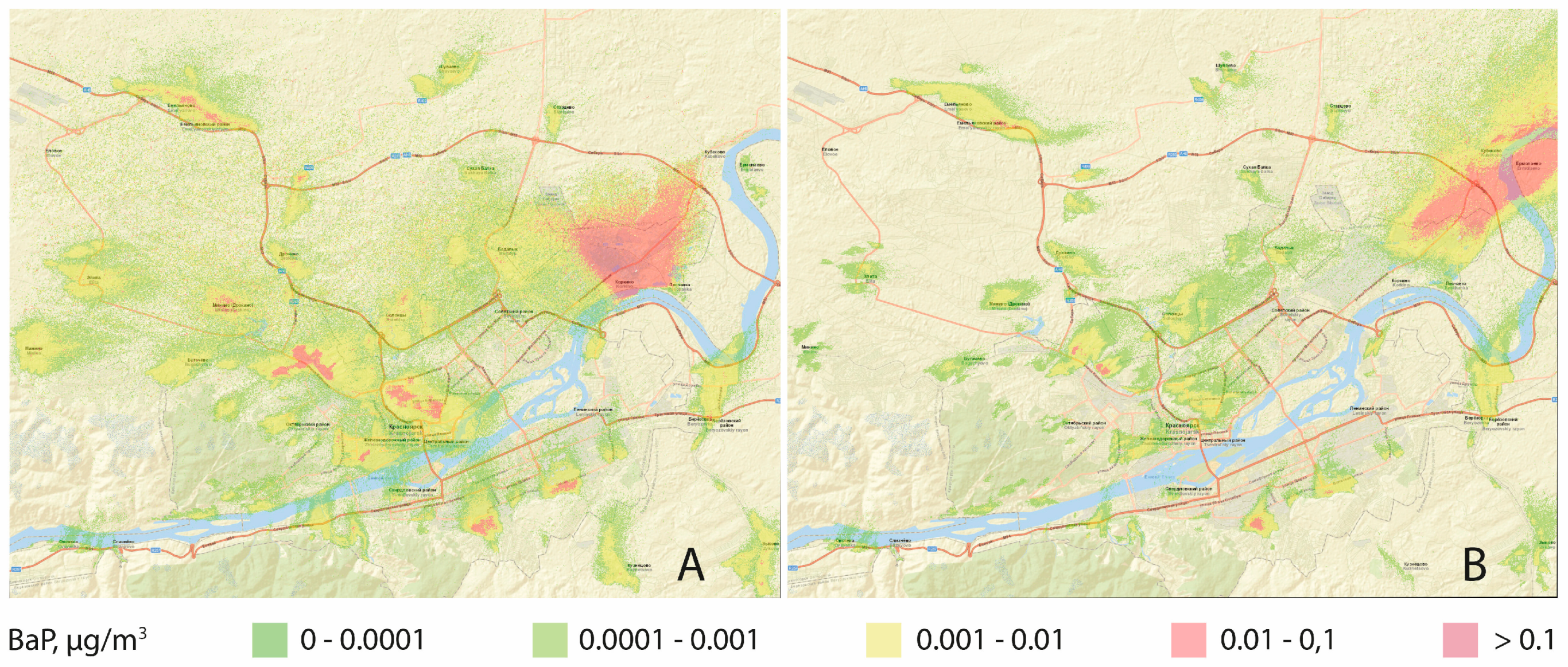
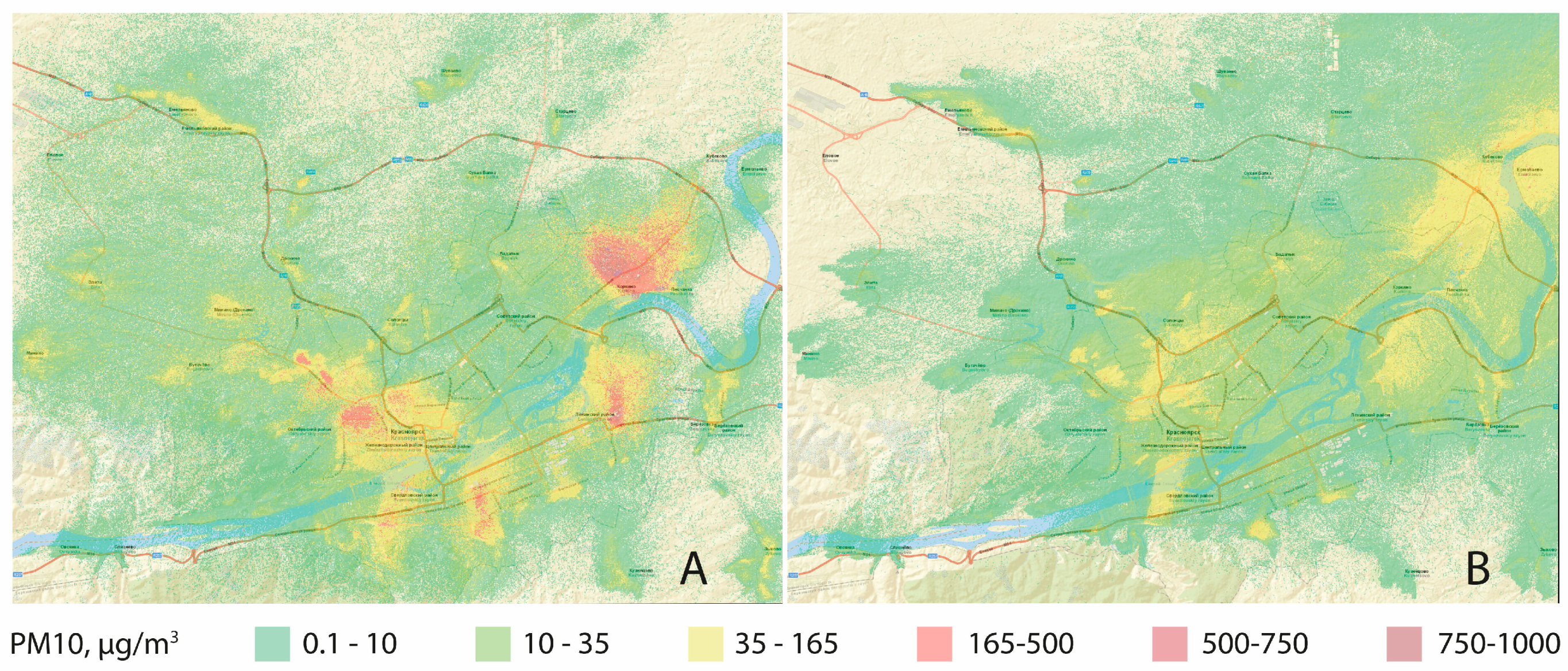
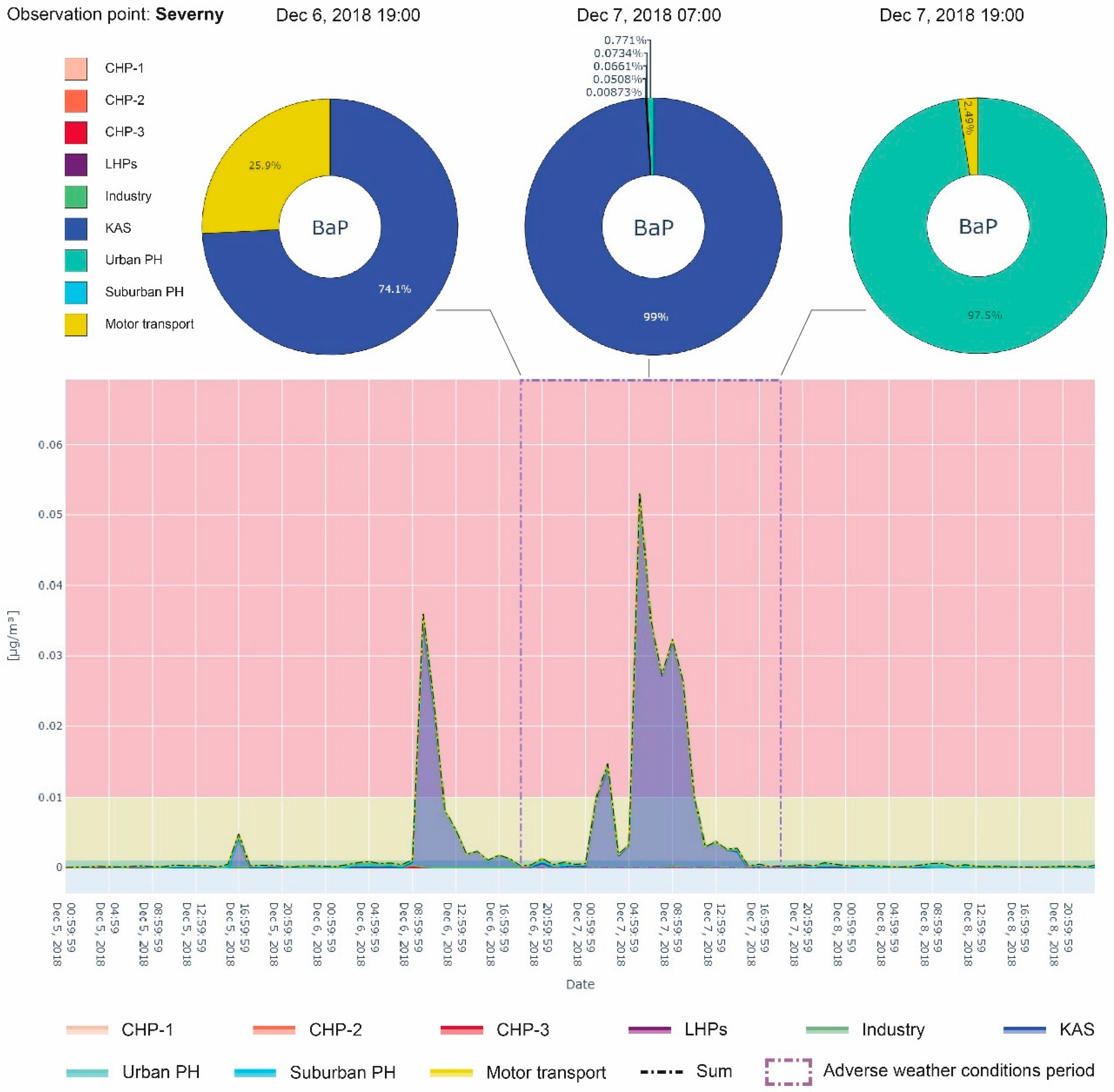
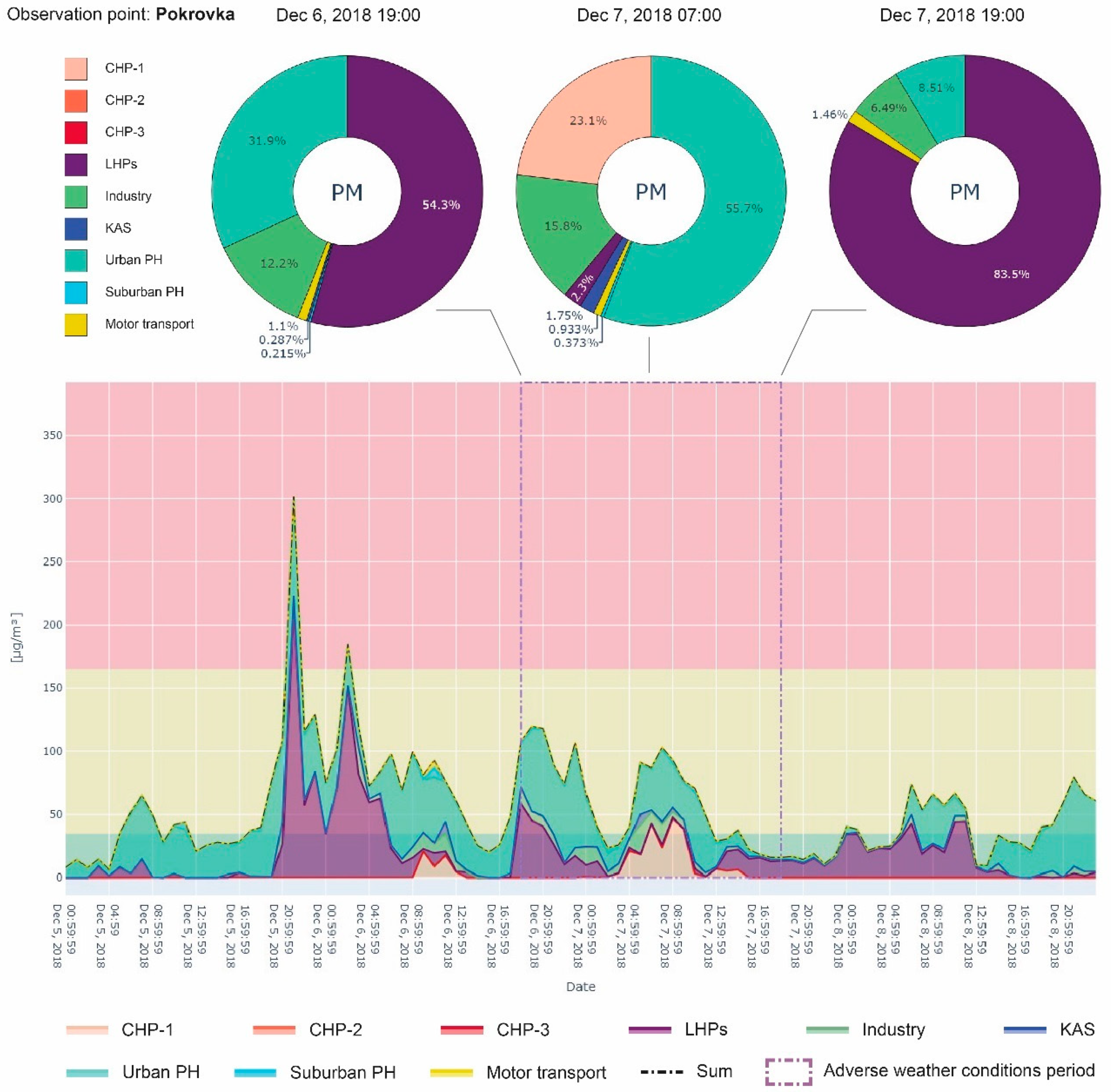
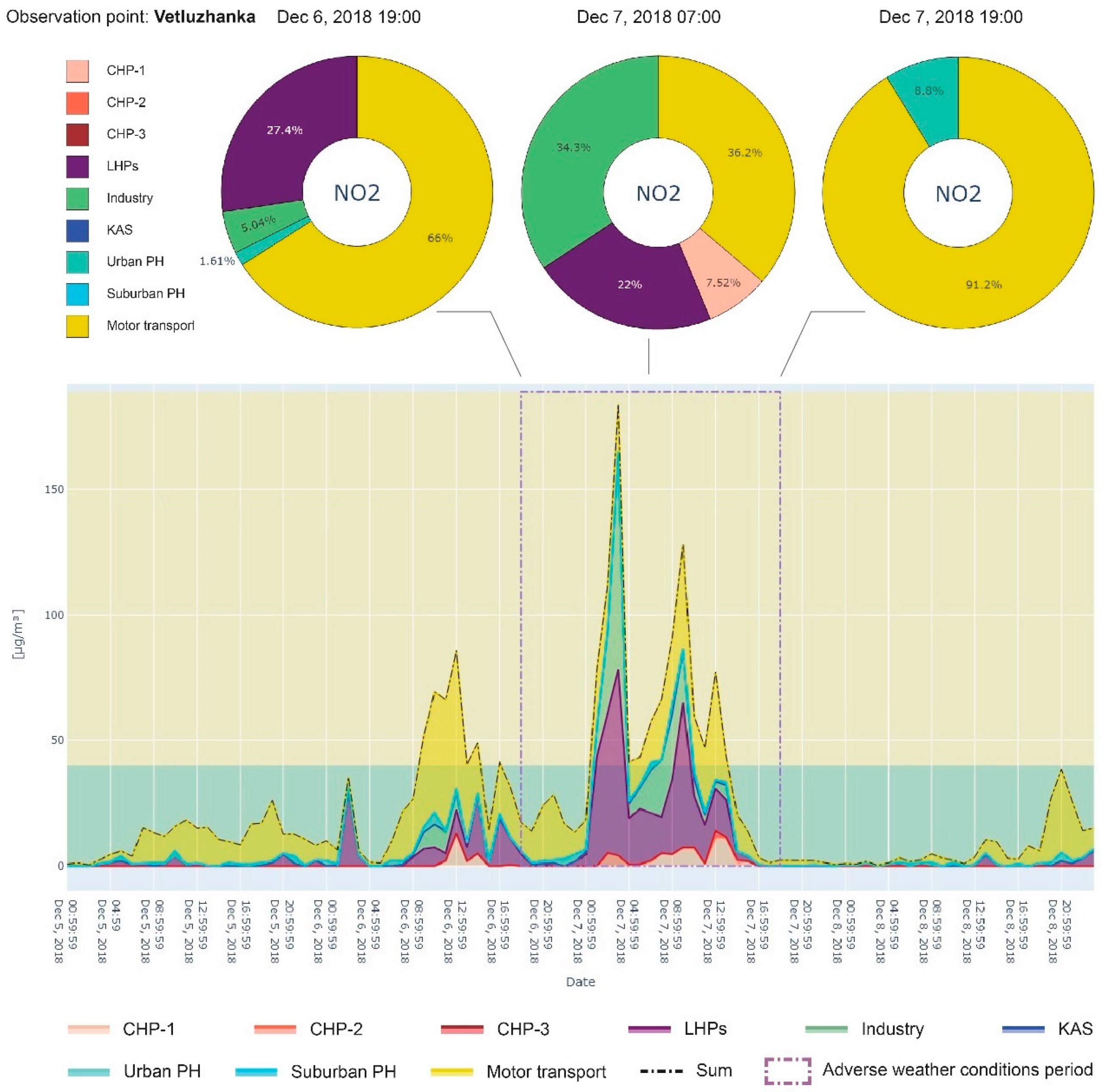
| Application | <1 km | 1–10 km | 10–100 km | 100–1000 km |
|---|---|---|---|---|
| Online risk management (short runtime is important) | - | Gaussian | Puff | Eulerian |
| Complex landscape | CFD | Lagrangian | Lagrangian | Eulerian |
| Reactive materials | CFD | Eulerian | Eulerian | Eulerian |
| Source–receptor sensitivity | CFD | Lagrangian | Lagrangian | Lagrangian |
| Long-term average loads | - | Gaussian | Gaussian | Eulerian |
| Free atmosphere dispersion (volcanoes) | - | Lagrangian | Lagrangian | Lagrangian |
| Convective boundary layer | CFD | Lagrangian | Eulerian | Eulerian |
| Stable boundary layer | CFD | Lagrangian | Eulerian | Eulerian |
| Urban areas, street canyon | CFD | CFD | Eulerian | Eulerian |
| Name | Value, Unit | Comments |
|---|---|---|
| GRAMM parameters | ||
| number of cells (l × w × h) | 454 × 418 × 20 | GRAM modeling area in cells |
| linear dimensions of the cell | 90 × 90 m | width and length of the cell |
| first layer height | 10 m | height of the first modeling layer |
| stretching factor | 1.16 | scale factor to underlain layer |
| height of the modeling area | 2506 m | height of the simulation area above sea level |
| GRAL parameters | ||
| number of cells (l × w × h) | 1118 × 779 × 80 | GRAL modeling area in cells |
| linear dimensions of the cell | 30 × 30 m | spatial resolution of modeling |
| first layer height | 2 m | at this level, the partial contributions of sources to pollution are fixed |
| stretching factor | 1.05 | scale factor to underlain layer |
| Pollutant | Comments | Health Impact | Main Sources |
|---|---|---|---|
| Particulate matter (PM) | include both coarse (diameter <10 μm, PM10) and fine (diameter <2.5 μm, PM2.5) particles | pulmonary inflammation, acute nasopharyngitis, cardiovascular diseases, and infant mortality [54,55,56]. | coal-fired heating plants and private households, aluminum smelter, industry, cement production, building sector, motor roads |
| Nitrogen dioxide (NO2) | as main and hazardous NOx component | respiratory diseases, coughing, wheezing, dyspnea, bronchospasm, and even pulmonary edema when inhaled at high levels [55] | fuel combustion, mostly heating plants and automotive engines exhaust |
| Sulfur dioxide (SO2) | region-specific pollutant | rapid-onset bronchoconstriction, respiratory irritation, bronchitis, mucus production, and bronchospasm [56,57] | coal burning, industry |
| Carbon monoxide (CO) | has a significant part of gross emissions value | headache, dizziness, weakness, nausea, vomiting, and, loss of consciousness [54] | produced by fossil fuel when combustion is incomplete |
| Benzo[a]pyrene (BaP) | very hazardous region-specific pollutant | most carcinogenic polycyclic aromatic hydrocarbon (PAH) an important risk factor for lung cancer [54,55] | aluminum smelter, fossil fuel private households heating |
| Group Index 1 | Group Name 1 | Description | Source Type |
|---|---|---|---|
| 1 | CHP—1 | Central Heating Plant—1, 485 MW, 1677 GCal/h | Point |
| 2 | CHP—2 | Central Heating Plant—2, 465 MW, 1405 GCal/h | Point |
| 3 | CHP—3 | Central Heating Plant—3, 208 MW, 582 GCal/h | Point |
| 4 | LHPs | Local Heating plants | Point |
| 5 | Industry | Enterprises—cement, asphalt, mechanical engineering, and metallurgical plants | Point |
| 6 | KAS | Krasnoyarsk Aluminum Smelter, the world second largest, about 1 Mt/y of aluminum | Point |
| 7 | Urban PH | Private households—Autonomous heating sources (AHS) that located in the Krasnoyarsk city borders | Area |
| 8 | Suburb PH | Private households—Autonomous heating sources (mostly villages and settlements) that located close to the Krasnoyarsk city borders | Area |
| 9 | Roads | Main transportation roads inside the Krasnoyarsk city | Linear |
| # 1 | NO2, kg/h | NO2, % GT 2 | PM10, kg/h | PM10, % GT | BaP, kg/h | BaP, % GT | SO2, kg/h | SO2, % GT | CO, kg/h | CO, % GT |
|---|---|---|---|---|---|---|---|---|---|---|
| 1 | 1061.8 | 21.9 | 2658.6 | 46.2 | 0.001360 | 0.44 | 2024.1 | 24.0 | 353.3 | 1.4 |
| 2 | 1328.8 | 27.5 | 278.9 | 4.8 | 0.000940 | 0.30 | 2222.6 | 26.4 | 115.9 | 0.4 |
| 3 | 485.6 | 10.0 | 82.8 | 1.4 | 0.000700 | 0.22 | 1382.4 | 16.4 | 68.6 | 0.3 |
| 4 | 624.2 | 12.9 | 956.0 | 16.6 | 0.001788 | 0.57 | 1203.4 | 14.3 | 2323.2 | 9.0 |
| 5 | 533.0 | 11.0 | 474.8 | 8.2 | 0.000395 | 0.13 | 355.4 | 4.2 | 1381.0 | 5.3 |
| 6 | 62.0 | 1.3 | 1017.4 | 17.7 | 0.264114 | 84.55 | 1142.5 | 13.5 | 7374.8 | 28.4 |
| 7 | 30.9 | 0.6 | 161.4 | 2.8 | 0.025329 | 8.11 | 56.5 | 0.7 | 7432.2 | 28.6 |
| 8 | 21.4 | 0.4 | 111.9 | 1.9 | 0.017560 | 5.62 | 39.2 | 0.5 | 5152.5 | 19.9 |
| 9 | 691.9 | 14.3 | 16.9 | 0.3 | 0.000207 | 0.07 | 8.3 | 0.1 | 1752.9 | 6.8 |
| GT2 | 4839.5 | 100 | 5758.7 | 100 | 0.312392 | 100 | 8434.4 | 100 | 25954.4 | 100 |
| # | Fuel Type | NO2 | SO2 | CO | BaP | Pm |
|---|---|---|---|---|---|---|
| 1 | Lignite | 0.0023 | 0.0068 | 0.2880 | 0.00000220 | 0.0125 |
| 2 | Firewood | 0.0014 | 0.0000 | 0.6120 | 0.00000086 | 0.0070 |
| 3 | 50/50 mix | 0.0019 | 0.0034 | 0.4500 | 0.00000153 | 0.0098 |
| City District | Date and Time Interval | ||||||
|---|---|---|---|---|---|---|---|
| 05.12 00–24 | 06.12 00–19 | 06.12 19–24 | 07.12 00–19 | 07.12 19–24 | 08.12 00–24 | Result Mode | |
| Cheryomushki | 0.03 | 0.03 | 0.03 | 0.03 | 0.03 | 0.05 | measured |
| 0.38 | 0.18 | 0.04 | 0.04 | 0.04 | 0.11 | simulated | |
| Severny | 0.13 | 0.16 | 0.14 | 0.14 | 0.08 | 0.10 | measured |
| 0.02 | 0.36 | 0.01 | 0.37 | 0.03 | 0.02 | simulated | |
| Vetluzhanka | 0.01 | 0.01 | 0.01 | 0.01 | 0.01 | 0.01 | measured |
| 0.02 | 0.20 | 0.01 | 0.22 | 0.00 | 0.02 | simulated | |
| Solnechny | 0.09 | 0.64 | 0.74 | 0.99 | 0.00 | 0.02 | measured |
| 0.01 | 0.28 | 0.10 | 0.30 | 0.01 | 0.00 | simulated | |
| Pokrovka | 0.20 | 0.18 | 0.17 | 0.11 | 0.02 | 0.08 | measured |
| 0.22 | 0.29 | 0.12 | 0.13 | 0.03 | 0.11 | simulated | |
| City District | Date and Time Interval | ||||||
|---|---|---|---|---|---|---|---|
| 05.12 00–24 | 06.12 00–19 | 06.12 19–24 | 07.12 00–19 | 07.12 19–24 | 08.12 00–24 | Result Mode | |
| Cheryomushki | 0.50 | 0.66 | 0.58 | 0.76 | 1.06 | 0.10 | measured |
| 0.17 | 0.16 | 0.04 | 0.10 | 0.06 | 0.23 | simulated | |
| Severny | 0.74 | 0.94 | 0.84 | 0.96 | 1.18 | 0.16 | measured |
| 0.12 | 0.30 | 0.11 | 0.27 | 0.08 | 0.10 | simulated | |
| Vetluzhanka | 0.48 | 0.80 | 1.06 | 1.18 | 0.78 | 0.60 | measured |
| 0.11 | 0.23 | 0.11 | 0.19 | 0.01 | 0.10 | simulated | |
| Solnechny | 0.36 | 0.78 | 0.86 | 1.22 | 0.04 | 0.08 | measured |
| 0.05 | 0.14 | 0.06 | 0.42 | 0.02 | 0.05 | simulated | |
| Pokrovka | 0.74 | 0.68 | 0.70 | 0.44 | 0.00 | 0.22 | measured |
| 0.68 | 0.74 | 0.66 | 0.62 | 0.04 | 0.66 | simulated | |
| City District | Date and Time Interval | ||||||
|---|---|---|---|---|---|---|---|
| 05.12 00–24 | 06.12 00–19 | 06.12 19–24 | 07.12 00–19 | 07.12 19–24 | 08.12 00–24 | Result Mode | |
| Cheryomushki | 0.33 | 0.38 | 0.32 | 0.49 | 0.54 | 0.27 | measured |
| 0.79 | 0.52 | 0.29 | 0.35 | 0.11 | 0.53 | simulated | |
| Severny | 1.01 | 1.13 | 1.02 | 1.06 | 0.94 | 0.55 | measured |
| 1.06 | 1.08 | 1.07 | 1.15 | 0.52 | 1.10 | simulated | |
| Vetluzhanka | 0.01 | 0.05 | 0.05 | 0.03 | 0.02 | 0.04 | measured |
| 0.13 | 0.43 | 0.14 | 0.92 | 0.01 | 0.19 | simulated | |
| Solnechny | 0.12 | 0.00 | 0.00 | n/a 1 | 0.07 | 0.08 | measured |
| 0.43 | 1.03 | 0.41 | 0.49 | 0.09 | 0.57 | simulated | |
| Pokrovka | 0.48 | 0.34 | 0.37 | 0.37 | n/a | 6.49 | measured |
| 0.75 | 0.75 | 0.38 | 0.45 | 0.10 | 0.30 | simulated | |
| City District | Date and Time Interval | ||||||
|---|---|---|---|---|---|---|---|
| 05.12 00–24 | 06.12 00–19 | 06.12 19–24 | 07.12 00–19 | 07.12 19–24 | 08.12 00–24 | Result Mode | |
| Cheryomushki | 0.03 | N/A 1 | N/A | N/A | N/A | N/A | measured |
| 0.85 | 0.46 | 0.21 | 0.46 | 0.09 | 0.39 | simulated | |
| Severny | N/A | N/A | N/A | N/A | N/A | N/A | measured |
| 0.05 | 0.91 | 0.27 | 1.72 | 0.15 | 0.10 | simulated | |
| Vetluzhanka | N/A | N/A | N/A | N/A | N/A | N/A | measured |
| 0.09 | 0.91 | 0.06 | 1.53 | 0.01 | 0.12 | simulated | |
| Solnechny | N/A | N/A | N/A | N/A | N/A | N/A | measured |
| 0.02 | 1.11 | 0.08 | 1.30 | 0.03 | 0.03 | simulated | |
| Pokrovka | 1.41 | 1.33 | 1.50 | 0.82 | 0.04 | 0.39 | measured |
| 1.19 | 1.16 | 0.75 | 0.64 | 0.12 | 0.50 | simulated | |
| Pollutant | SO2 | CO | NO2 | BaP | PM10 | Total # |
|---|---|---|---|---|---|---|
| peak MPC | ||||||
| number of total mappings | 30 | 30 | 30 | 0 | 7 | 97 |
| number of satisfactory fitness (<1 shares of MPC) | 30 | 28 | 28 | 0 | 7 | 93 |
| number of outstanding fitness (<0.1 shares of MPC) | 18 | 7 | 10 | 0 | 1 | 36 |
| day mean MPC | ||||||
| number of total mappings | 10 | 10 | 8 | 14 | 2 | 44 |
| number of passably fitness (<1 shares of MPC) | 10 | 10 | 6 | 3 | 2 | 31 |
| number of outstanding fitness (<0.1 shares of MPC) | 2 | 3 | 0 | 0 | 0 | 5 |
Publisher’s Note: MDPI stays neutral with regard to jurisdictional claims in published maps and institutional affiliations. |
© 2020 by the authors. Licensee MDPI, Basel, Switzerland. This article is an open access article distributed under the terms and conditions of the Creative Commons Attribution (CC BY) license (http://creativecommons.org/licenses/by/4.0/).
Share and Cite
Romanov, A.A.; Gusev, B.A.; Leonenko, E.V.; Tamarovskaya, A.N.; Vasiliev, A.S.; Zaytcev, N.E.; Philippov, I.K. Graz Lagrangian Model (GRAL) for Pollutants Tracking and Estimating Sources Partial Contributions to Atmospheric Pollution in Highly Urbanized Areas. Atmosphere 2020, 11, 1375. https://doi.org/10.3390/atmos11121375
Romanov AA, Gusev BA, Leonenko EV, Tamarovskaya AN, Vasiliev AS, Zaytcev NE, Philippov IK. Graz Lagrangian Model (GRAL) for Pollutants Tracking and Estimating Sources Partial Contributions to Atmospheric Pollution in Highly Urbanized Areas. Atmosphere. 2020; 11(12):1375. https://doi.org/10.3390/atmos11121375
Chicago/Turabian StyleRomanov, Aleksey A., Boris A. Gusev, Egor V. Leonenko, Anastasia N. Tamarovskaya, Alexander S. Vasiliev, Nikolai E. Zaytcev, and Ilia K. Philippov. 2020. "Graz Lagrangian Model (GRAL) for Pollutants Tracking and Estimating Sources Partial Contributions to Atmospheric Pollution in Highly Urbanized Areas" Atmosphere 11, no. 12: 1375. https://doi.org/10.3390/atmos11121375
APA StyleRomanov, A. A., Gusev, B. A., Leonenko, E. V., Tamarovskaya, A. N., Vasiliev, A. S., Zaytcev, N. E., & Philippov, I. K. (2020). Graz Lagrangian Model (GRAL) for Pollutants Tracking and Estimating Sources Partial Contributions to Atmospheric Pollution in Highly Urbanized Areas. Atmosphere, 11(12), 1375. https://doi.org/10.3390/atmos11121375








